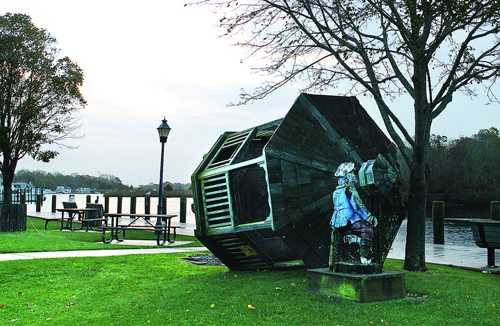One year after Sandy, FEMA money trickling in

Nearly a year after superstorm Sandy swept across the North Fork, knocking down trees, taking out power lines and flooding downtown Riverhead under several feet of storm surge, Riverhead Town is still waiting on about $750,000 in federal reimbursement funds it requested to cover related repair costs.
“We have received money, but not the lion’s share,” said Police Chief David Hegermiller, the town’s liaison to the Federal Emergency Management Agency.
Chief Hegermiller said the town applied for more than $1 million in funding from FEMA to pay for repairs and minor improvements to mitigate future storm damage. But as of last week, the town has received only about 25 percent of those reimbursement funds.
Related: Timeline breaks down Sandy’s arrival to the Riverhead area
Until a couple of months ago, he said, the town hadn’t received any funding from FEMA.
Chief Hegermiller believes the sheer amount of damage caused by Sandy across the U.S. is partially to blame for the delay in getting FEMA funding approval.
“This was just a major storm,” he said. “The paperwork is just drowning them.”
The complexity of the FEMA funding approval process may also be contributing to the delay. Municipalities that apply for FEMA relief don’t receive the funds directly from FEMA, but through the New York State Office of Emergency Management — to which FEMA gives the money. Applicants have to file project worksheets — detailed folders describing the exact cost and reason for the request — with state officials, who review the project worksheets themselves before sending them on to FEMA for a second review.
Click here to read our past Superstorm Sandy coverage.
Often, the state will return a worksheet asking for clarifications.
“I don’t want to tell you how many times I went down to Iron Pier to look at the concrete that was out of kilter,” Chief Hegermiller said. “All that stuff takes time.”
The town has completed most of the 20 project worksheets it plans to fi le with FEMA. Consultants from the state are now working in the police department basement to review the final worksheets for approval, town offi cials said. “We’re not the only ones in this position,” said town fi nancial administrator Bill Rothaar.
Most of the money used during Sandy cleanup came from budget lines set up for employee overtime and contingencies, meaning no money was taken from the general fund in 2012, he said.
But “a couple” of Sandy-related problems that cropped up this year had to be paid for using general funds because FEMA approval was taking too long, Mr. Rothaar said.
“We weren’t getting approvals and the board was making decisions that this needed to be done,” he said.
The delays, in turn, have also slowed down other town functions and departments. The town’s audit, for example, could have been fi nished about a month earlier had the FEMA funding been in the town’s coffers.
The town has also applied for several state hazard mitigation project grants to help bolster the its defenses against future disasters, Chief Hegermiller said.
One of those applications would secure $6.5 million to prevent storm-water from getting into the town’s sewer system, while another roughly $8.5 million proposal would move the sewer district’s Defriest pump station downtown to elevate it out of the fl ood plain, he said.
Another proposal asks for $350,000 to pay for a new generator. But Chief Hegermiller thinks the grants will become “very competitive.” Only $200 million has been made available for the mitigation grants across the entire state.
“This isn’t a slam dunk,” he said. “There’s a lot of hurdles to go through.”
Meanwhile, town officials say that a plan to install a series of plastic walls to prevent storm surges from flooding downtown is still in the planning phases.
A Utah-based company presented the “Muscle Wall” to Town Board members in April. The 6-by-4-foot sections of plastic wall would be placed together to keep floodwaters from reaching downtown’s businesses, as occurred during Sandy.
Councilwoman Jodi Giglio said the town will seek federal and county grant money to pay for the walls.
“We don’t have any money to buy it right now but I was hoping to use the hazard mitigation money FEMA and the county were putting on the table,” Ms. Giglio said.




